Ready to increase your revenue?
Join thousands of ecommerce brands using PostPilot to acquire more customers & keep them coming back again (and again).
No contracts. No minimums.

You could make a strong case for direct mail being the most personalized form of marketing.
Beyond your products themselves, it’s the only way to get your message and style into customers’ (or potential customers’) hands, where they can physically interact with something that you designed for them.
We think that’s pretty cool.
But to ensure that your mail gets seen and actually resonates on a deeper level by your entire intended audience… That requires a bit more thought and tech than asking a printer to send some slapped-together postcard designs to a list of folks on a CSV.
We think of personalization in three ways:
Really, we might want to call this article “How to Personalize Direct Mail at Scale (That Drives the Best Results).”
Ultimately, this one’s fairly simple and comes down more to the style of the postcard.
Most printers or direct mail platforms (those worth their salt, at any rate) should be able to handle either printing off a list of postcards based on a CSV or dynamically adding [first_name], as with an email or SMS.
HOWEVER… You shouldn’t always add a first name. To that end, we’ll explain with a few examples.
In acquisition and retargeting campaigns, you should generally be treating mailers as handheld ads. For instance, here’s a postcard that Liquid I.V. sent as part of a prospecting campaign.
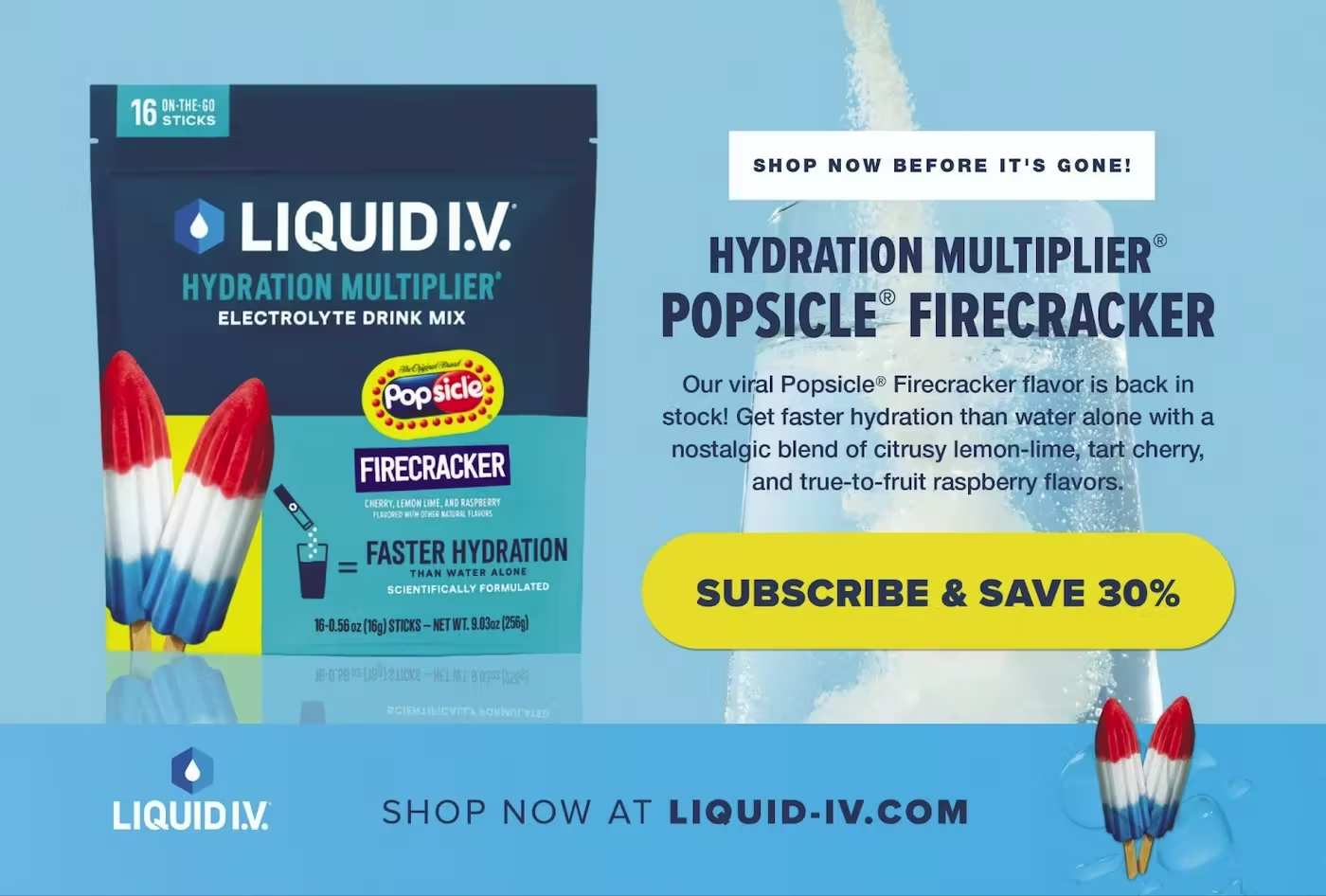
The design is colorful, inviting, and looks like a digital ad or mini billboard. But there’s no message to the recipient—which makes sense, because you don’t actually know them.
Of course, the back of the postcard will have the individual’s name and address, but in the same way you wouldn’t (hopefully) stalk a stranger, go up to them on the street, and greet them by their first name, you shouldn’t greet strangers in a cold (or even lukewarm) mail setting.
Lukewarm example: Caddis sends—likewise bright and colorful—postcards to retarget and convert anonymous site visitors who had never purchased before.

This design, too, is like a handheld digital ads, but it doesn’t include any copy that addresses the recipient by name.
In situations where you “know” the recipient (i.e., they’re actually a customer rather than a prospect), you can add a personalized message.
Promix sends these automated VIP postcards to high-value customers (purchased 4+ times) who haven’t purchased in at least 60 days, and on each is a note directly addressing the recipient.
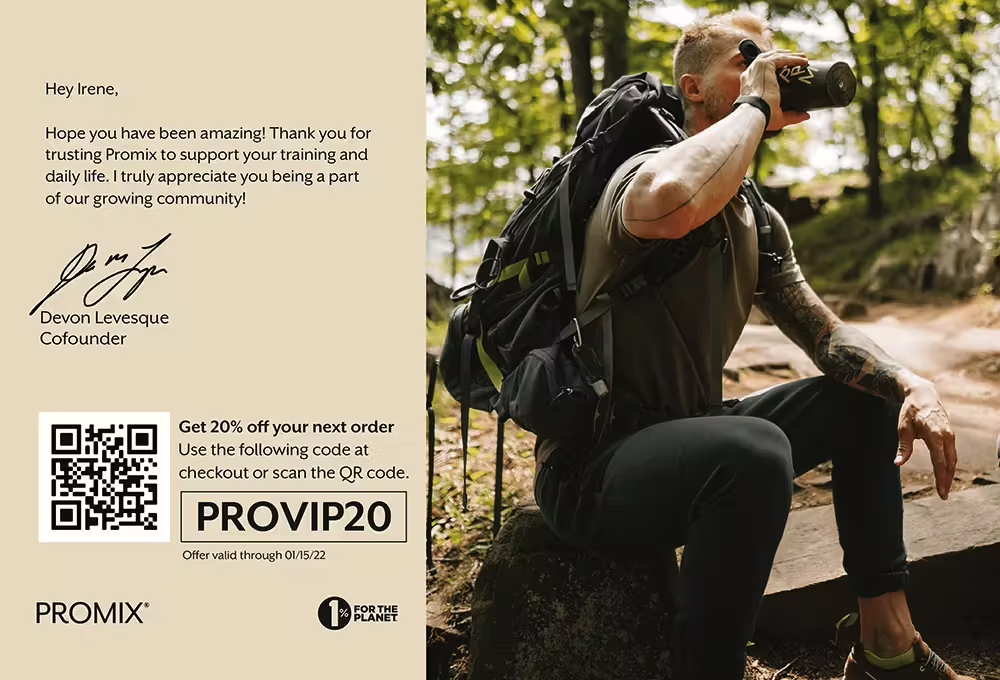
Similarly, Hat Heaven has sent postcards to their previous customers with a short message on the back of the postcard:
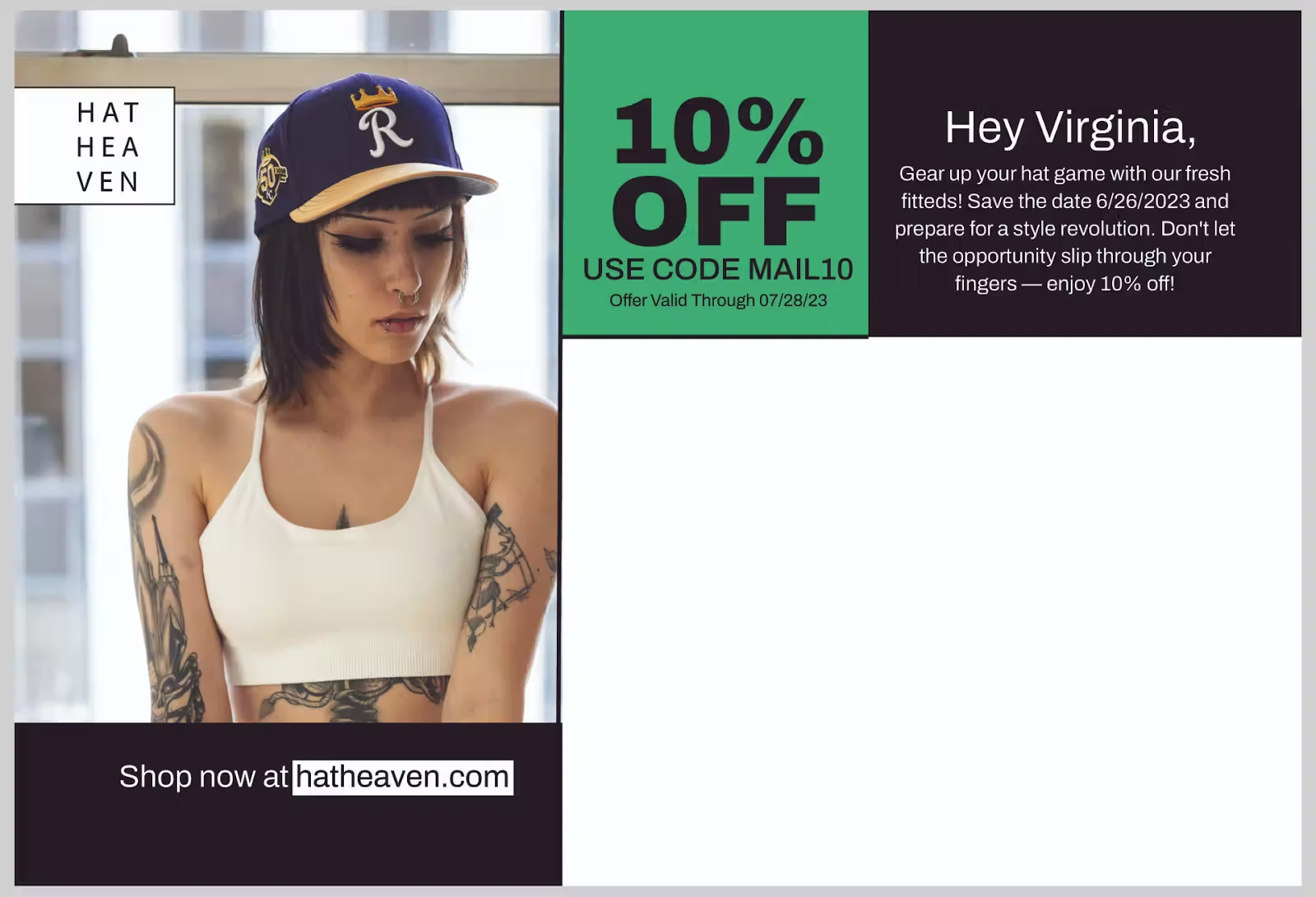
Adding the first name is a simple, but effective touch to add a little bit more 1:1 in your marketing.
But you can take it a step further when you bring in handwritten postcards.
Brands including Red Land Cotton and Country Life Natural Foods supplement their greater direct mail programs with automated handwritten direct mail.

Red Land Cotton sends automated handwritten birthday cards to customers every year—and because they use PostPilot (that’s us!), they don’t need to integrate any .csv or loyalty program data because we have a robust data set that includes most US customers’ birthdays.
And Country Life Natural Foods sends handwritten cards to all customers who spent more than a hundred dollars on their first purchases.

By the way… The copy in this Country Life’s postcard is fantastic—it tells customers to “keep this card near your fridge.” Direct mail already has staying power and tends to hang around on desks, tables, and, indeed, fridges. But by putting the suggestion in customers’ heads, it’s more likely they’ll do it!
To us, the next step of personalizing mail—and marketing in general—is actually meeting customers where they are and timing offers based on their buying behavior.
For most brands, a retention program should be rooted in time between orders data, which should in turn inform RFM.
The reasoning here: all ecommerce brands have typical purchase intervals where customers can be “expected” to repurchase within a particular timeframe between their first and second, second and third, etc., orders. We recommend that any owned marketing, including direct mail, is triggered if a customer does not purchase within the expected timeframe.
If you do so, you’ll be meeting customers where they are—instead of sending offers too early or too late.
We offer free time between orders reports out-of-the-box for a reason: they’re vital for timing offers.

Based on this report we presented, you can see…
In terms of personalizing based on buying behavior, we’d probably see some great results by firing off a postcard after someone passes the 30-day mark—30 days is a fairly standard time period between first and second purchases, but it does vary based on the brand, generally depending on AOV.
Leveraging this data, we can start to layer out an overall retention strategy with direct mail using RFM segments.
As a reminder, RFM (recency, frequency, monetary) is a segmentation method dating back decades, and it remains the most powerful framework for timing repeat purchases outside of cutting-edge AI segmentation.
Let’s assume the brand above has an AOV of $100—an RFM segment targeting the one-time buyers might be:
This would likely be a great starting place to send a postcard, and beyond that, we could probably build a few other segments to target (variation is in the recency):

By timing our direct mail offers to arrive at the initial lapsed interval and at a few other key dates, we’re ensuring that spend is optimized, and that a customer is going to continue to receive relevant offers. Only customers who still haven’t purchased will receive postcards, and the rest can be sent specific offers to drive additional purchases.
For instance, a set of postcards to drive second purchases might have these parameters:
By setting up automated postcards in PostPilot, you can set up these automations once and generally forget about them—although some optimization a few times a year works wonders, as does tailoring postcards to your seasonal offers/product drops.
By “high RFM,” we effectively mean “VIP customers.” And again, this may vary heavily by brand. For some brands, this may be customers who purchased more than 10 times and spent 1200 dollars, and for others, it may be customers who purchased 3+ times and spent over $250.
In the end, though, you can roll out a similar set of RFM segmentation principles based on your brand’s typical behavior, and you’ll have yourself a killer VIP retention strategy—with a few extra recency segments for good measure; you don’t want to lose these customers! For instance:
We highly recommend using RFM because, unlike simply LTV segmentation, RFM takes actual recent behavior into consideration. If you’re at a brand that has been around for a decade, you may have customers who purchased an extraordinary amount, but they may have made their last purchase 8 years ago.
There is plenty of opportunity to get granular and set up a couple dozen automated postcards with many designs based on previous product purchased. But to start out, there are a couple tactics (low-hanging fruit, really) that you can implement to drive reliable repeat revenue.
It’s a classic for a reason. If you have a hero product, you can offer the most common second product purchased after your hero.

Pipeliners Cloud, an industrial brand, sends one-time buyers who purchased one of their welding umbrellas an offer featuring a welding umbrella stand.
As another example, BlendJetⓇ has sent cross-sell accessory offers through the mail:
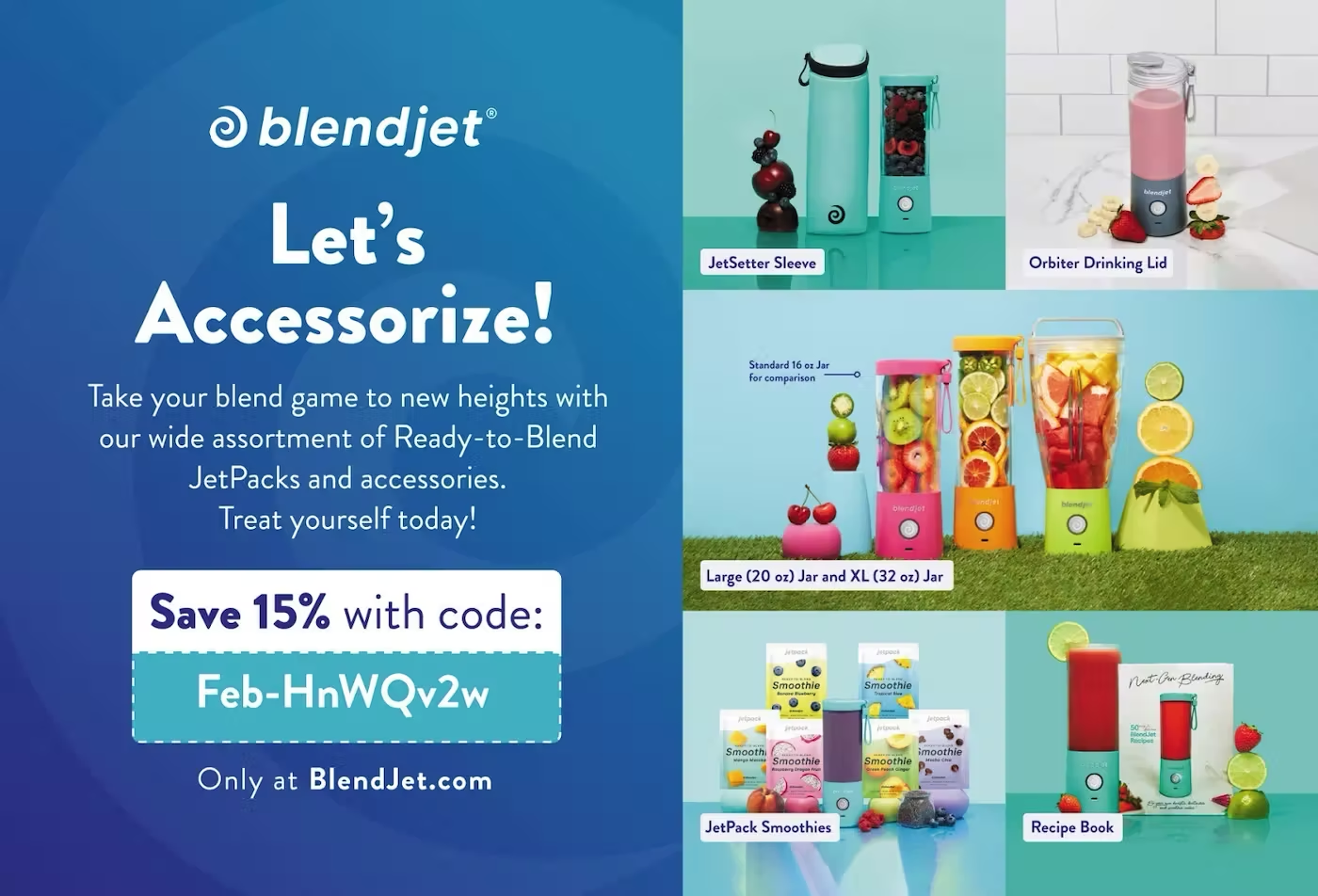
BlendJet’s JetPacks are a perfect complement to blender buyers—and they look pretty great on a postcard.
Direct mail continues to be a super effective tactic to reactivate subscription customers, and there’s an incredible opportunity for personalization here that we’d love to see more of: sending anti-churn postcards based on the reason someone churned from the subscription program.
Here’s how a DTC legend did it:
Laird Superfood has a robust Recharge subscription program, and they’re using direct mail in a variety of ways to enhance and expand it.
The team automates postcards to customers who have unsubscribed from their subscription program, and they’ve added creative and copy relevant to the cancelation reason. For instance, the postcard below was sent to customers who unsubscribed because the subscription was too expensive:
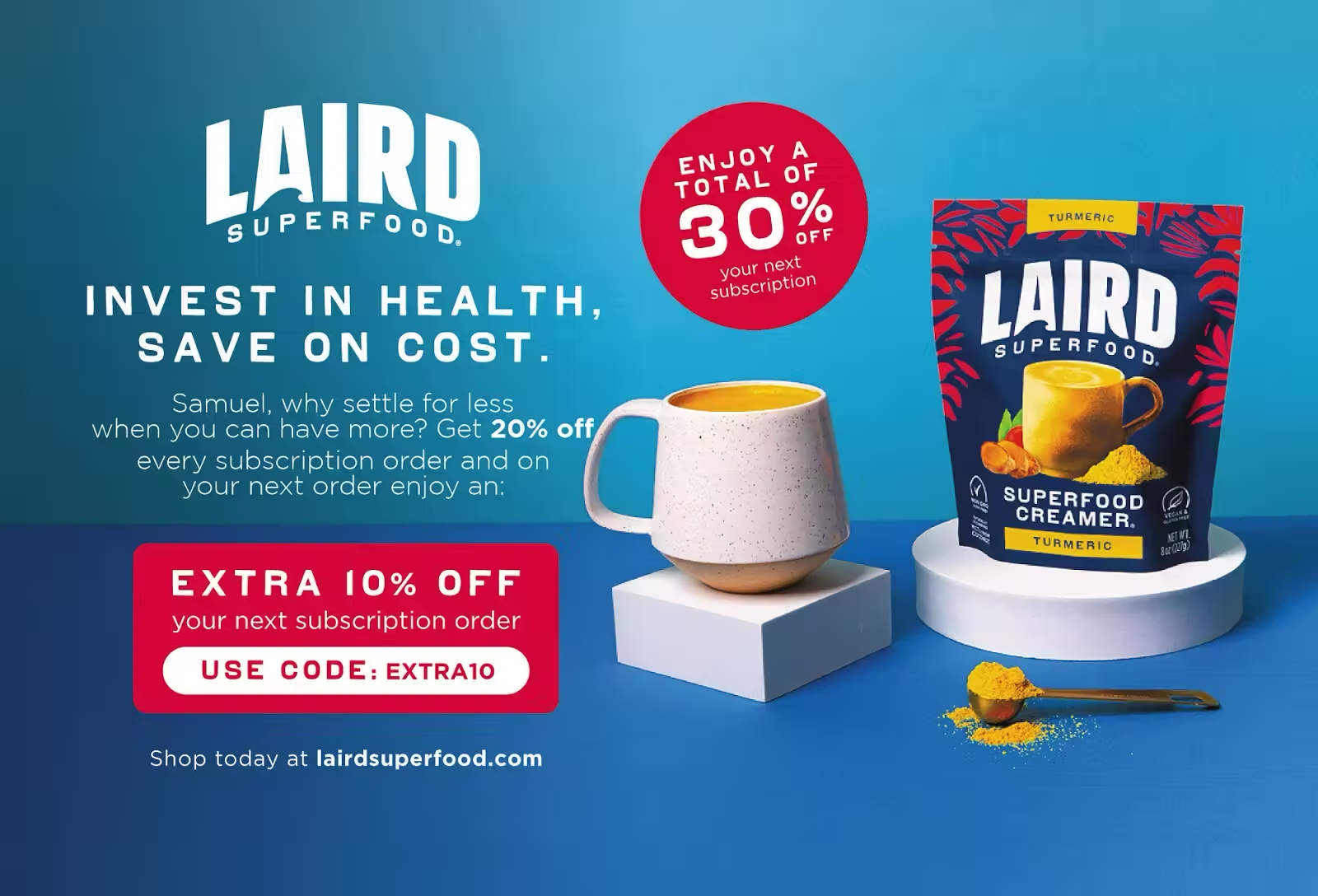
And the postcard below here was sent cards to customers who churned because they had too much product and may have preferred other flavors. A more general offer was sent to customers who marked “other.”

At PostPilot, we leverage RFM as a foundational automated retention strategy for our customers, but we are also pioneering AI in the direct mail space.
The goal being to not only drive awesome, hyper-targeted, hyper-hyper personalized results elsewhere in the funnel: with prospecting and retargeting.
Here’s an overview of a couple of our key products that use AI.
PostPilot's AcquisitionAI uses a proprietary algorithm trained on more than 200 million U.S. consumers to build direct mail lookalike audiences.
And it works.
For example: The beloved nursing and maternity wear brand Kindred Bravely uses direct mail at every stage of the customer journey, and the team used AcquisitionAI to send mail to tens of thousands of new and expecting mothers.
And the results? Excellent. The campaign drove a 3.1x ROAS on that cold outreach.
(Actually, we snuck this in earlier in the piece.)
PostPilot’s SiteMatchTM technology allows ecommerce brands to target and convert anonymous site visitors and is an intent-based personalization algorithm. It works with a proprietary pixel—it allows us to pool site visitors, score their likelihood to convert based on our dataset, and dynamically fire off mailers to those visitors based on scores.

Brands like Gozney and Caddis have used SiteMatch to great effect, driving strong ROIs and converting traffic that they spent valuable prospecting dollars bringing to their sites.
Foundationally, personalizing direct mail comes down to thinking about your customers and meeting them where they are.
If you’re looking to add personalization throughout the funnel—and add 10% to your annual revenue using direct mail—we’re here to help.
Read more about PostPilot, or contact us if you’re ready for a personalized demo of how direct mail could work for your brand.
1. What personalization features should i look for in a direct mail platform?
Answer: You should be able to add dynamic fields to postcard copy including name and behavioral/tech stack data, such as loyalty points, previous product purchased, and more. This total functionality is only possible with PostPilot.
2. What are some reliable platforms for creating personalized postcard marketing campaigns at scale?
Answer: PostPilot is truly the only direct mail platform that can offer maximal personalization at scale, ranging from AI- and RFM-powered targeting (which are uniquely powerful for targeting) to in-postcard dynamic fields, which enable you to create postcards with true 1:1 personalization details using data from your entire ecommerce tech stack.
You could make a strong case for direct mail being the most personalized form of marketing.
Beyond your products themselves, it’s the only way to get your message and style into customers’ (or potential customers’) hands, where they can physically interact with something that you designed for them.
We think that’s pretty cool.
But to ensure that your mail gets seen and actually resonates on a deeper level by your entire intended audience… That requires a bit more thought and tech than asking a printer to send some slapped-together postcard designs to a list of folks on a CSV.
We think of personalization in three ways:
Really, we might want to call this article “How to Personalize Direct Mail at Scale (That Drives the Best Results).”
Ultimately, this one’s fairly simple and comes down more to the style of the postcard.
Most printers or direct mail platforms (those worth their salt, at any rate) should be able to handle either printing off a list of postcards based on a CSV or dynamically adding [first_name], as with an email or SMS.
HOWEVER… You shouldn’t always add a first name. To that end, we’ll explain with a few examples.
In acquisition and retargeting campaigns, you should generally be treating mailers as handheld ads. For instance, here’s a postcard that Liquid I.V. sent as part of a prospecting campaign.

The design is colorful, inviting, and looks like a digital ad or mini billboard. But there’s no message to the recipient—which makes sense, because you don’t actually know them.
Of course, the back of the postcard will have the individual’s name and address, but in the same way you wouldn’t (hopefully) stalk a stranger, go up to them on the street, and greet them by their first name, you shouldn’t greet strangers in a cold (or even lukewarm) mail setting.
Lukewarm example: Caddis sends—likewise bright and colorful—postcards to retarget and convert anonymous site visitors who had never purchased before.

This design, too, is like a handheld digital ads, but it doesn’t include any copy that addresses the recipient by name.
In situations where you “know” the recipient (i.e., they’re actually a customer rather than a prospect), you can add a personalized message.
Promix sends these automated VIP postcards to high-value customers (purchased 4+ times) who haven’t purchased in at least 60 days, and on each is a note directly addressing the recipient.

Similarly, Hat Heaven has sent postcards to their previous customers with a short message on the back of the postcard:

Adding the first name is a simple, but effective touch to add a little bit more 1:1 in your marketing.
But you can take it a step further when you bring in handwritten postcards.
Brands including Red Land Cotton and Country Life Natural Foods supplement their greater direct mail programs with automated handwritten direct mail.

Red Land Cotton sends automated handwritten birthday cards to customers every year—and because they use PostPilot (that’s us!), they don’t need to integrate any .csv or loyalty program data because we have a robust data set that includes most US customers’ birthdays.
And Country Life Natural Foods sends handwritten cards to all customers who spent more than a hundred dollars on their first purchases.

By the way… The copy in this Country Life’s postcard is fantastic—it tells customers to “keep this card near your fridge.” Direct mail already has staying power and tends to hang around on desks, tables, and, indeed, fridges. But by putting the suggestion in customers’ heads, it’s more likely they’ll do it!
To us, the next step of personalizing mail—and marketing in general—is actually meeting customers where they are and timing offers based on their buying behavior.
For most brands, a retention program should be rooted in time between orders data, which should in turn inform RFM.
The reasoning here: all ecommerce brands have typical purchase intervals where customers can be “expected” to repurchase within a particular timeframe between their first and second, second and third, etc., orders. We recommend that any owned marketing, including direct mail, is triggered if a customer does not purchase within the expected timeframe.
If you do so, you’ll be meeting customers where they are—instead of sending offers too early or too late.
We offer free time between orders reports out-of-the-box for a reason: they’re vital for timing offers.

Based on this report we presented, you can see…
In terms of personalizing based on buying behavior, we’d probably see some great results by firing off a postcard after someone passes the 30-day mark—30 days is a fairly standard time period between first and second purchases, but it does vary based on the brand, generally depending on AOV.
Leveraging this data, we can start to layer out an overall retention strategy with direct mail using RFM segments.
As a reminder, RFM (recency, frequency, monetary) is a segmentation method dating back decades, and it remains the most powerful framework for timing repeat purchases outside of cutting-edge AI segmentation.
Let’s assume the brand above has an AOV of $100—an RFM segment targeting the one-time buyers might be:
This would likely be a great starting place to send a postcard, and beyond that, we could probably build a few other segments to target (variation is in the recency):

By timing our direct mail offers to arrive at the initial lapsed interval and at a few other key dates, we’re ensuring that spend is optimized, and that a customer is going to continue to receive relevant offers. Only customers who still haven’t purchased will receive postcards, and the rest can be sent specific offers to drive additional purchases.
For instance, a set of postcards to drive second purchases might have these parameters:
By setting up automated postcards in PostPilot, you can set up these automations once and generally forget about them—although some optimization a few times a year works wonders, as does tailoring postcards to your seasonal offers/product drops.
By “high RFM,” we effectively mean “VIP customers.” And again, this may vary heavily by brand. For some brands, this may be customers who purchased more than 10 times and spent 1200 dollars, and for others, it may be customers who purchased 3+ times and spent over $250.
In the end, though, you can roll out a similar set of RFM segmentation principles based on your brand’s typical behavior, and you’ll have yourself a killer VIP retention strategy—with a few extra recency segments for good measure; you don’t want to lose these customers! For instance:
We highly recommend using RFM because, unlike simply LTV segmentation, RFM takes actual recent behavior into consideration. If you’re at a brand that has been around for a decade, you may have customers who purchased an extraordinary amount, but they may have made their last purchase 8 years ago.
There is plenty of opportunity to get granular and set up a couple dozen automated postcards with many designs based on previous product purchased. But to start out, there are a couple tactics (low-hanging fruit, really) that you can implement to drive reliable repeat revenue.
It’s a classic for a reason. If you have a hero product, you can offer the most common second product purchased after your hero.

Pipeliners Cloud, an industrial brand, sends one-time buyers who purchased one of their welding umbrellas an offer featuring a welding umbrella stand.
As another example, BlendJetⓇ has sent cross-sell accessory offers through the mail:

BlendJet’s JetPacks are a perfect complement to blender buyers—and they look pretty great on a postcard.
Direct mail continues to be a super effective tactic to reactivate subscription customers, and there’s an incredible opportunity for personalization here that we’d love to see more of: sending anti-churn postcards based on the reason someone churned from the subscription program.
Here’s how a DTC legend did it:
Laird Superfood has a robust Recharge subscription program, and they’re using direct mail in a variety of ways to enhance and expand it.
The team automates postcards to customers who have unsubscribed from their subscription program, and they’ve added creative and copy relevant to the cancelation reason. For instance, the postcard below was sent to customers who unsubscribed because the subscription was too expensive:

And the postcard below here was sent cards to customers who churned because they had too much product and may have preferred other flavors. A more general offer was sent to customers who marked “other.”

At PostPilot, we leverage RFM as a foundational automated retention strategy for our customers, but we are also pioneering AI in the direct mail space.
The goal being to not only drive awesome, hyper-targeted, hyper-hyper personalized results elsewhere in the funnel: with prospecting and retargeting.
Here’s an overview of a couple of our key products that use AI.
PostPilot's AcquisitionAI uses a proprietary algorithm trained on more than 200 million U.S. consumers to build direct mail lookalike audiences.
And it works.
For example: The beloved nursing and maternity wear brand Kindred Bravely uses direct mail at every stage of the customer journey, and the team used AcquisitionAI to send mail to tens of thousands of new and expecting mothers.
And the results? Excellent. The campaign drove a 3.1x ROAS on that cold outreach.
(Actually, we snuck this in earlier in the piece.)
PostPilot’s SiteMatchTM technology allows ecommerce brands to target and convert anonymous site visitors and is an intent-based personalization algorithm. It works with a proprietary pixel—it allows us to pool site visitors, score their likelihood to convert based on our dataset, and dynamically fire off mailers to those visitors based on scores.

Brands like Gozney and Caddis have used SiteMatch to great effect, driving strong ROIs and converting traffic that they spent valuable prospecting dollars bringing to their sites.
Foundationally, personalizing direct mail comes down to thinking about your customers and meeting them where they are.
If you’re looking to add personalization throughout the funnel—and add 10% to your annual revenue using direct mail—we’re here to help.
Read more about PostPilot, or contact us if you’re ready for a personalized demo of how direct mail could work for your brand.
1. What personalization features should i look for in a direct mail platform?
Answer: You should be able to add dynamic fields to postcard copy including name and behavioral/tech stack data, such as loyalty points, previous product purchased, and more. This total functionality is only possible with PostPilot.
2. What are some reliable platforms for creating personalized postcard marketing campaigns at scale?
Answer: PostPilot is truly the only direct mail platform that can offer maximal personalization at scale, ranging from AI- and RFM-powered targeting (which are uniquely powerful for targeting) to in-postcard dynamic fields, which enable you to create postcards with true 1:1 personalization details using data from your entire ecommerce tech stack.

Join thousands of ecommerce brands using PostPilot to acquire more customers & keep them coming back again (and again).
No contracts. No minimums.
